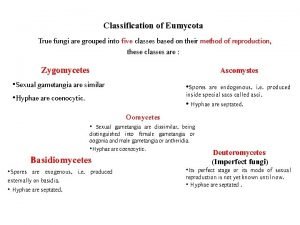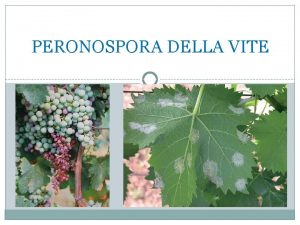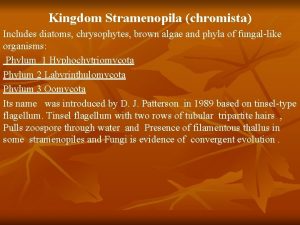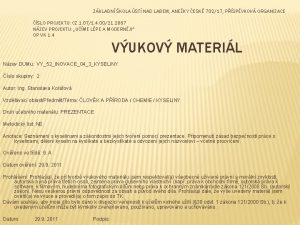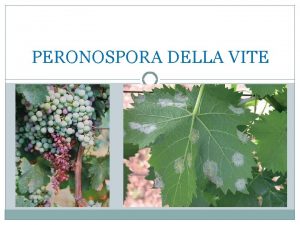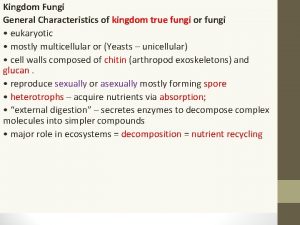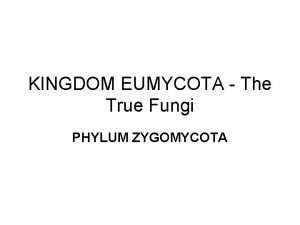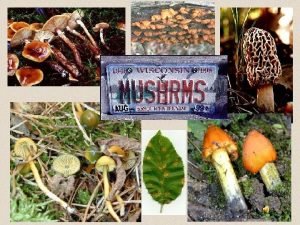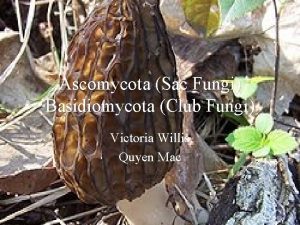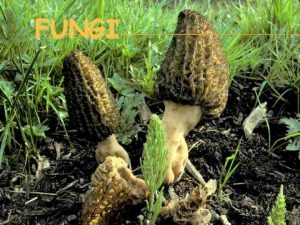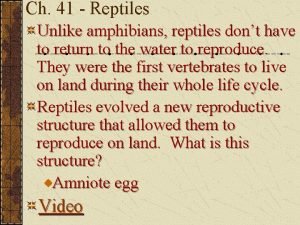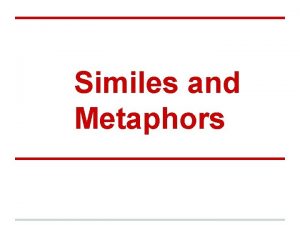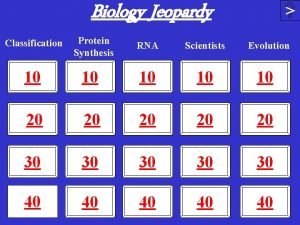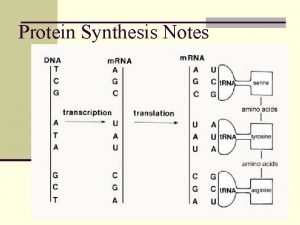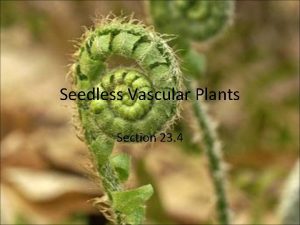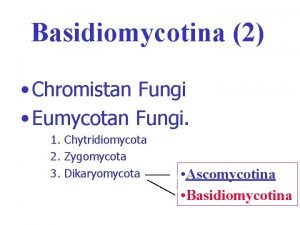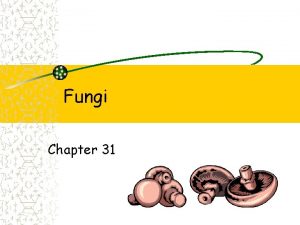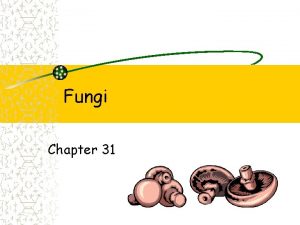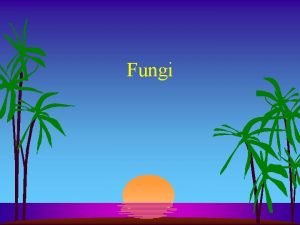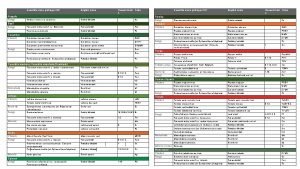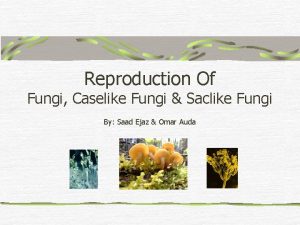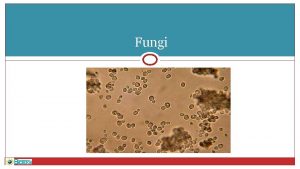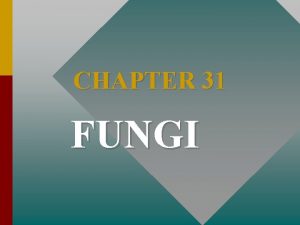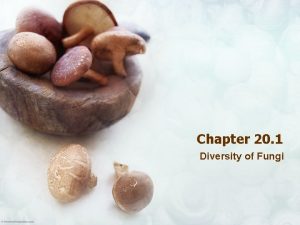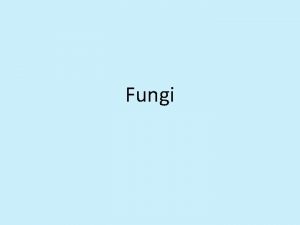Eumycotan Fungi Eumycotan Fungi Unlike Chromista true fungi






























- Slides: 30

Eumycotan Fungi

Eumycotan Fungi Unlike Chromista, true fungi have chitin walls, store their food as glycogen and most have no motile stages. • Phylum - Chytridiomycota, exception - do have flagellae - 1 posterior whiplash, • Phylum - Zygomycota most have coenocytic hyphae (ie no septae) • Phylum Glomeromycota newly formed group - coenocytic, form endomycorrhizae • Phylum- Dikaryomycota (Ascomycota + Basidiomycota) septate hyphae. Largest and most important group.

Variations in Nuclear cycles in Fungi • Chromista - Oomycetes – mainly diploid, short haploid phase • Eumycota - Chytridiomycota – variable, some have alternate haploid and diploid generations • Eumycota - all other groups – mainly haploid, short diploid phase

Eumycotan Fungi By far the largest group of fungi: • over 100, 000 sp known • probably well over 1, 000 exist! • many capable of digesting very complex substances (cellulose, lignin, melanin, chitin, keratin ) - due to extracellular enzymes • hyphae can penetrate into solid masses e. g wood and decompose it rapidly • produce vast numbers of spores so capable of spreading rapidly.

Phylum Chytridiomycota – mostly live in water or soil - decomposers and parasites – earliest fungal fossils – single cell or hyphae, sometimes develop rhizoids – some show alternation of generations – can utilize wide range of substrates - chitin, keratin and cellulose – Synchytrium causes wart disease of potatoes – Allomyces (Fig 2. 7 and lab exercise) – some show sexual differentiation of gametes (anisogamy)

Phylum Chytridiomycota – 1999 - evidence found for a new genus of chytrid fungus, Batrachochytrium, which is killing frogs all over the world. – See Allomyces life cycle, Fig. 2. 7

Allomyces

Chytrid fungi on decaying leaf in river or pond This type is eucarpic having separate rhizoids and reproductive parts. Others are holocarpic - only have reproductive parts

Potato wart disease Synchytrium endobioticum • severe effect on yield • resistant varieties available - but new virulent strains of fungus arising • warts contain sporangia which release zoospores infect new potatoes - cause rapid cell division = wart

Zygomycetes - main features Phylum Zygomycota • wide, thin-walled multinucleate coenocytic hyphae i. e no septae • limited ability to digest complex substrates • sexual spore = a thick walled zygospore - formed by the physical blending - fusion or conjugation - of morphologically similar gametangia. The zygosporangium germinates by meiosis to form new hyphae. • Asexual spores - sporangia containing 1 to many sporangiospores

Eumycotan Fungi Phylum - Zygomycota • class Zygomycetes – Mucorales - saprobic (eg bread moulds) • common saprophytes - but limited ability to degrade complex compounds compared to Dikaryomycota • Life cycle - see Rhizopus stolonifer (Fig 3. 5) – Entomophthorales - insect parasites – Kickxellales - complex anamorphs – Glomales - important as mycorrhizae. Recently raised to level of phylum, Glomeromycota, in the Eumycota • class Trichomycetes - parasites of arthropods

Bread Mould - Rhizopus stolonifer

Asexual stages anamorph Sexual stages teleomorph Mucor - Life Cycle

The asexual spores are usually formed inside sporangia borne at the tips of specialized sporangiophores. Zygomycete cell walls are mainly of chitin and the nuclei in their vegetative hyphae are haploid Sporangium containing many sporangiospores (asexual) sporangiophore Sporangium in Rhizopus

Asexual reproduction. The sporangium contains many haploid sporangiospores

Cunninghamella sporangiophore From “Tom Volk’s Fungi“ (http: //botit. botany. wisc. edu/toms_fungi/)

Some Zygomycetes produce much smaller asexual structures called sporangiola with far fewer ‘spores’. Some sporangiola have only one spore

Anamorphs in Zygomycetes This fungus is found in rat dung. Why such complex spore structures ?

Two sexually compatible strains of Phycomyces blakesleeanus were inoculated on opposite sides of the plate (dark spots). Where the mycelia met, a line of zygosporangia with spiny appendages formed.

Some species - homothallic - gametangia arise from one mycelium. Others heterothallic gametangia arise from different mycelia

Zygospore of Rhizopus (diploid - will go through meiosis)

• Most Mucorales are saprobes • Some are plant pathogens (Rhizopus stolonifer - soft rot of strawberries) • Some are human pathogens • Some species are important in production of chemicals (e. g. Rhizopus sp. in manufacture of fumaric, lactic and other acids

Spore dispersal in Pilobolus Why ? Beneath the black apical sporangium is a lenslike vesicle, with lightsensitive `retina' that controls the growth of the sporangiophore, aiming it toward any light source i. e. it is phototropic. Pressure in the sporangiophore and the subsporangial vesicle builds up to >7 kilograms /cm 2 - the vesicle explodes & hurls the sporangium up to 2 m, directly toward the light. The mucilaginous contents of the vesicle go with the sporangium, gluing it to whatever it lands on.

Entomophthorales Entomophthora muscae infects, and eventually kills, houseflies. Dying flies, their bodies riddled by the fungus usually crawl into exposed situations -- where the fungal infection bursts through the insects' exoskeleton and produces tightly-packed masses of sporangiophores

• class Zygomycetes – Mucorales – Entomophthorales - insect parasites – Kickxellales - complex anamorphs – Glomales • Glomales - now raised to phylum level Glomeromycota • Extremely important as form arbuscular mycorrhizae (AM) or endomycorrhizae with 90% of plant sp. • No sexual stages known • form large asexual spores • cannot be cultured • thought to be few species with wide host ranges - but ? ? ?

GLOMEROMYCOTA readily recognized because of their arbuscules inside host cells; also their lipid filled vesicles

Glomeromycota have large asexual spores - in some cases big enough to see with the eye (2 mm)

Endomycorrhizae are essential for normal growth in many plants. With mycorrhizal fungus without mycorrhizae

Follow-up to lecture • read Chaps. 2 and 3 text • view Web/CDROM images • review lecture slides - Bio 318 b Web page

Follow-up to lecture • know main groups of Chromistan and Eumycotan fungi and how to distinguish. • Important economic species • key life cycles • Allomyces, Rhizopus/Mucor (Fig 3. 5) • review terms • homothallic/heterothallic; anamorph/ teleomorph; saprobic/parasitic; chitin/cellulose; eucarpic/holocarpic • rhizoid, anisogamy, zygospore, sporangium /sporangiospore, gametangia.
 Structure of rhizopus fungi
Structure of rhizopus fungi Cenocitiche
Cenocitiche Kingdom stramenopila
Kingdom stramenopila Kyselina selenovodíková vzorec
Kyselina selenovodíková vzorec Zoosporangi
Zoosporangi Chapter 2 jesus christ true god and true man
Chapter 2 jesus christ true god and true man Amer rasheed
Amer rasheed Chytridiomycota
Chytridiomycota Characteristics of zygomycotina
Characteristics of zygomycotina Club fungi are morels truffles bracket fungi yeast
Club fungi are morels truffles bracket fungi yeast Club fungi
Club fungi Basidiomycota rusts and smuts
Basidiomycota rusts and smuts Unlike amphibians reptiles
Unlike amphibians reptiles Boring similes
Boring similes Unlike traditional production rules, association rules
Unlike traditional production rules, association rules Brainpop adding fractions
Brainpop adding fractions Adding mixed numbers unlike denominators
Adding mixed numbers unlike denominators Watch?v=dckvspcd8gs
Watch?v=dckvspcd8gs Anorexics are unlike bulimics in that they __________.
Anorexics are unlike bulimics in that they __________. Unlike routine claims, persuasive claims:
Unlike routine claims, persuasive claims: Unlike photoautotrophs chemoautotrophs obtain energy
Unlike photoautotrophs chemoautotrophs obtain energy Unlike dna, rna
Unlike dna, rna What is parallel force
What is parallel force How is the crucible unlike the salem witch trials?
How is the crucible unlike the salem witch trials? An ingredient that can permanently bind unlike ingredients
An ingredient that can permanently bind unlike ingredients Personification in shall i compare thee to a summer's day
Personification in shall i compare thee to a summer's day Foil character in hamlet
Foil character in hamlet Unlike bryophytes, lycophytes
Unlike bryophytes, lycophytes Unlike psychological tests, behavioral assessments record
Unlike psychological tests, behavioral assessments record Like terms and unlike terms in polynomials
Like terms and unlike terms in polynomials Like fractions examples
Like fractions examples
